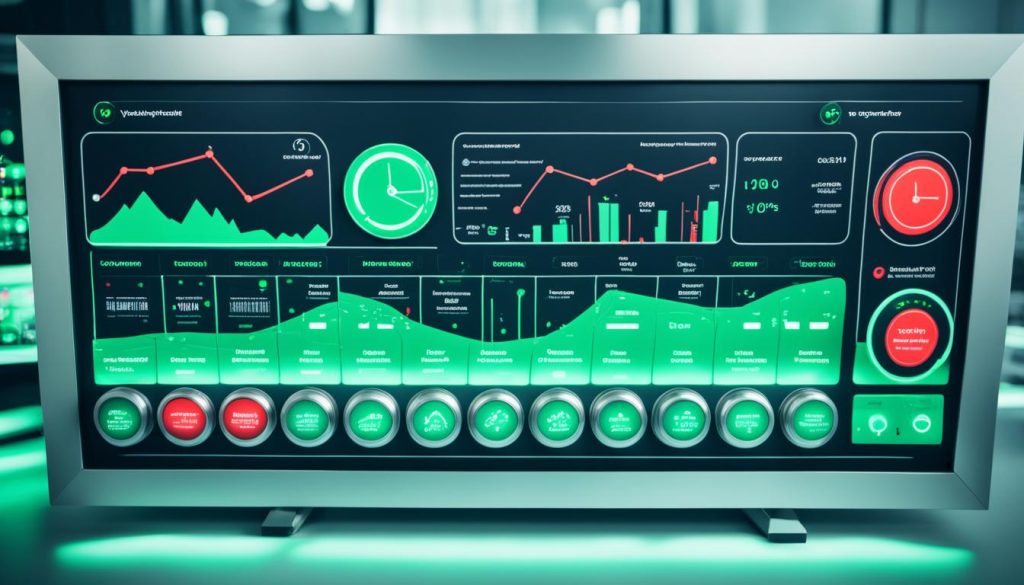Ever wondered how those ads at the top of your search results got there? Or how advertisers target you online? It’s all thanks to pay per click (PPC) advertising. This article will make PPC easy to understand. It shows how businesses use it to bring more visitors to their websites.
PPC is a type of digital marketing. Advertisers pay a fee each time someone clicks on their ad. So, every click is a chance to meet a potential customer. You might wonder how it all works. Why is PPC so effective? Let’s explore these questions.
How Pay Per Click Advertising Works
- PPC advertising means paying for each click on an ad.
- PPC ads can be on search engines, websites, and social media.
- Search engine advertising is the most common PPC, with Google Ads leading.
- PPC helps businesses reach specific people and get more website visitors.
- Knowing how PPC works is key to improve campaigns and increase ROI.
What is PPC?
Pay-per-click (PPC) is a digital advertising model where advertisers pay for each ad click. It differs from traditional advertising because you only pay when someone clicks your ad. This approach is great for bringing targeted visitors to websites or landing pages.
PPC ads are seen on search engines, websites, and social media platforms. They reach a lot of potential customers. It’s a way for businesses to connect with people looking for related content.
Advertisers can make different kinds of PPC ads, like text, images, or videos. This variety helps grab the attention of their target audience in an effective way.
The Benefits of PPC Advertising
PPC advertising has a lot of pluses for businesses:
- Cost-Effective: You only pay for actual clicks on your ad, saving you money.
- Targeted Reach: You can specifically target your ads to reach the right people based on things like keywords and interests.
- Immediate Results: PPC can quickly drive traffic to your site or landing page right after your ads are live.
- Measurable Performance: You can see detailed analytics from PPC platforms. This lets businesses track how well their ads are doing.
- Flexibility and Control: You have complete control over your PPC campaigns. This includes how you spend your budget and who sees your ads.
In brief, PPC advertising is an impactful way for businesses to connect with their audience. It supports businesses in driving the right traffic to their sites. This can increase visibility, engage customers, and boost conversions.
How does PPC advertising work?
PPC advertising is a powerful way to market online. It goes through a clear process. Here’s a breakdown of how it works:
- Choosing a Campaign Type: First, advertisers pick a type of campaign that fits their goals. Options include search ads, display ads, video ads, and app ads.
- Refining Settings and Targeting: Then, they tweak their campaign settings. This ensures their ads reach the correct audience. They choose locations, languages, and devices to target.
- Setting Budget and Bidding Strategy: Next, they decide on a budget and how much they’ll bid for clicks. This strategy is crucial for cost control.
- Inputting a Destination URL or Landing Page: Advertisers provide a URL or landing page. This is where users go after clicking the ad.
- Building the Ad: Finally, they create the ad. They write engaging copy, select visuals, and use keywords. The ad must grab the target audience’s attention.
After setting up, the ad goes live. Its placement, visibility, and click cost are set by an algorithm. Google Ads, for example, uses an auction. It considers the budget, bid, settings, and the ad’s quality and relevance.
Now, let’s look more into how PPC works, focusing on Google Ads, the top platform.
What is Google Ads?
Google Ads is the world’s top PPC advertising system. It lets businesses create ads that show on Google’s search engine and other Google properties.
Advertisers pick keywords to focus on with their ads and bid on them. Then the ads go into an auction. Here, things like quality score, bid, and how relevant the ad is decide its rank and where it’s placed.
This platform helps businesses reach lots of people. They can generate traffic and get leads.
How Does Google Ads Work?
Advertisers select keywords that match their business and audience. They make ads and bid on keywords to set their ad’s position.
The auction system looks at quality score, how much you bid, and ad relevance to decide rank. The best-ranked ads show up on the search results page when someone searches something related.
Google Ads lets businesses control their budget. They can target specific places and groups and see how their ads do.
Benefits of Google Ads
Google Ads has many benefits for businesses:
- High visibility: Google is the go-to search engine. It ensures ads are seen by many potential customers.
- Precise targeting: Advertisers can target the exact keywords, places, languages, and people they want.
- Measurable results: Google Ads gives detailed analytics. Advertisers can see how their ads perform and make informed decisions.
- Flexibility: Advertisers can change their budget, bids, and targeting anytime. This control helps manage costs and strategy.
Get Started with Google Ads
To start using Google Ads, follow these steps:
- Create a Google Ads account or sign in if you already have one.
- Set what you want to achieve and your budget.
- Choose who and where you want to reach.
- Find and pick keywords that matter to your business.
- Write great ads and create eye-catching visuals (if needed).
- Place your bids and kick off your campaigns.
- Keep an eye on your ads and tweak them to do better.
With Google Ads, businesses can reach their ideal customers. They can boost their brand and bring more traffic to their websites.
How PPC Works in Google Ads
As an advertiser using Google Ads, you can reach your target audience well. I’ll explain how PPC in Google Ads works and its mechanics.
Choosing Targeted Keywords
In Google Ads, you start by picking keywords for your ads. These keywords match what you’re selling or offering. By knowing what potential customers are looking for, you can target your campaigns better.
Bidding on Keywords
After picking your keywords, you bid on them. Your bid decides how much you pay when someone clicks your ad. Think about the competition for keywords and your budget when you bid.
Determining Ad Rank
Your ad’s spot on the search results page comes down to your ad rank. Ad rank is based on ad relevance, expected click rate, and landing page quality. A higher ad rank means a better spot for your ad.
Appearing on the SERP
When a search matches your keywords, Google Ads picks which ads show on the search results page. Ads with top ad rank scores get shown to the user. This makes sure the best, most relevant ads reach potential customers.
Reaching Your Target Audience
Google Ads helps you effectively find your target audience. By picking the right keywords, bidding carefully, and optimizing your ads, you can show your business to potential customers looking for what you offer.


| Advantages of PPC in Google Ads | Challenges of PPC in Google Ads |
|---|---|
|
|
How to do PPC with Google Ads
Google Ads can boost your PPC campaign, helping you hit your target audience. Follow these important steps:
1. Conduct Thorough Keyword Research
Begin by doing deep keyword research for Google Ads. Find keywords that match your business and audience. Using popular and long-tail keywords can attract more targeted visitors.
2. Create Ad Groups with Tight Keyword Groups
Create ad groups based on closely related keywords. This helps you craft ads more relevant to each audience segment. It also improves your PPC campaign’s effectiveness.
3. Optimize Landing Page Quality
Your landing page’s quality is crucial. Ensure it has relevant content and a clear call to action (CTA). Aligning landing pages with search intents boosts user experience and ad success.
4. Improve Quality Score with Best Practices
Your ad’s quality score is vital in Google Ads. Improve it by using relevant ad texts, including targeted keywords, and by optimizing the landing page. A high quality score improves ad position and can lower costs.
5. Craft Enticing Ad Copy and Eye-Catching Creative
Make your ad copy compelling to encourage clicks. Your ad’s creative, whether text, image, or video, must align with your goals and speak to your audience. Visually appealing ads can boost click-through rates and conversions.
| Benefits of Doing PPC with Google Ads |
|---|
| 1. Wide reach and access to a large audience |
| 2. Targeted advertising to reach specific audience segments |
| 3. Effective budget control and performance tracking |
| 4. Flexibility to optimize campaigns based on real-time data |
| 5. Various ad formats and placements to suit your needs |
To make the most of Google Ads for your PPC efforts, continuously monitor and adjust your strategies. Constantly evaluate and refine your campaigns for the best ROI.
How to do effective PPC keyword research
PPC keyword research is key to a successful campaign. It’s about finding keywords that match your business and audience. You need to make lists of popular and long-tail keywords. These can drive focused traffic to your site or page. Even though long-tail keywords have less competition, they’re great for reaching specific people. It’s crucial to keep refining your keyword lists to improve your PPC campaigns.
The Free Keyword Tool is really helpful for keyword research. It lets you find big, industry-specific keywords fitting your campaign. This tool gives insights and shows new opportunities to target your audience well. By using it, you can find highly searched keywords. This increases your chances of connecting with potential customers.
Benefits of Effective PPC Keyword Research
- Improved targeting: The right keywords help you precisely target your ads and reach the audience you want.
- Increased conversion rates: Relevant keywords draw in users looking for what you offer, boosting the chance they’ll convert.
- Lower cost per click: Long-tail keywords often face less competition, making them cheaper than highly competitive ones.
- Enhanced ad relevance: Good keyword research creates ads that match your target audience’s search intent perfectly.
- Continuous improvement: Regularly updating your keyword lists keeps you competitive in an ever-changing market.
To do great PPC keyword research, know your target audience and how they search. Think like them to find the best keywords. Also, looking at your competitors’ ads can give hints about which keywords to target. This helps you stay competitive in the market.
Managing your PPC campaigns
Managing PPC campaigns is crucial to ensure they keep doing well. As an advertiser, I know how important it is to regularly check and improve campaign performance. This way, I can make the most of my advertising efforts.
Adding relevant keywords is a key part of managing PPC campaigns. By doing frequent keyword research and expanding my lists, I make sure my ads reach the right people. Using high-volume, specific keywords boosts traffic and leads.
It’s also vital to add negative keywords. They stop my ads from showing up on irrelevant searches. This ensures I target the most suitable audience and get more for every click.
Reviewing costly keywords is another important step. I keep an eye on keyword performance and their cost-effectiveness. This helps me decide which keywords to keep and how to adjust their bids.
Improving landing pages for specific searches is crucial. I make sure my landing pages have relevant, helpful content. This enhances user experience and increases chances of conversion.
Splitting ad groups helps improve click-through rates and quality scores. By creating smaller, targeted ad groups, my ads are more in line with user searches. This makes my ads more relevant.
I always work to manage and better my PPC campaigns. By keeping track of metrics like click-through rates, conversion rates, and return on ad spend, I can spot areas to improve. This allows me to make informed choices to make campaigns more effective.
To show the impact of good PPC campaign management, look at this table:
| Metrics | Before Optimization | After Optimization |
|---|---|---|
| Click-Through Rate (CTR) | 2.5% | 4.7% |
| Conversion Rate | 3% | 6% |
| Return on Ad Spend (ROAS) | 250% | 400% |


The table shows how effective PPC campaign management can really boost key metrics. It highlights the gains in click-through rate (CTR), conversion rate, and return on ad spend (ROAS). These results emphasize the value of continuous management to improve performance and meet goals.
Get started with PPC
To begin your PPC journey, first, create a Google Ads account or pick a PPC platform you like. Learn how your chosen platform works and explore its features. Getting started with PPC means doing deep keyword research to find terms that fit your business goals. Picking the correct keywords is key for your beginning PPC advertising to reach the right people.
After finding your keywords, it’s time to make targeted campaigns. Write ad copy that speaks to your audience and include strong calls-to-action. Make sure your campaigns target specific groups and places to get better results.
While running your PPC campaign, always keep an eye on and refine your ads for the best outcomes. Use tools like the Google Ads Performance Grader to check on your progress and adjust as needed. Staying on top of tracking and adjusting is crucial for starting Google Ads campaigns successfully.
Key steps to getting started with PPC:
- Create a Google Ads account or choose your preferred PPC platform.
- Get to know the platform’s interface and features.
- Look for relevant keywords through research.
- Build targeted campaigns that meet your goals and target audience.
- Regularly watch and improve your campaigns for the best results.
Best PPC Platforms
Choosing the right platform for PPC advertising is key to maximizing your ad’s reach. Several popular options exist, each with unique features. Here are three top PPC platforms:
1. Google Ads
Google Ads is the most used PPC platform. You can reach a huge audience on Google’s search engine and other sites. It offers great targeting, analytics, and is easy to use. Businesses big or small can use Google Ads to meet various advertising goals.
2. Bing Ads
Bing Ads is a good choice for those on a budget, though it’s not as big as Google Ads. It works on the Bing and Yahoo search networks. Bing Ads have lower costs and can reach different audiences, helping you save money.
3. Facebook Ads
Facebook Ads lets you advertise on the world’s largest social media site. It targets over two billion people based on their interests and more. It’s great for targeting specific consumer groups with visual content, helping you reach your target audience.
Comparison of PPC Platforms
Here’s a look at the key features and benefits of these PPC platforms:
| PPC Platform | Main Features | Targeting Options | Ad Distribution | Cost Structure |
|---|---|---|---|---|
| Google Ads | Extensive reach, robust analytics, various ad formats | Keywords, demographics, location, interests, and more | Google search results, Google Display Network, YouTube | Cost-per-click (CPC), cost-per-impression (CPM) |
| Bing Ads | Lower CPC, integration with Yahoo search results | Keywords, demographics, location, device targeting | Bing search results, Yahoo search results | Cost-per-click (CPC) |
| Facebook Ads | Extensive targeting options, visual ad formats | Interests, demographics, behaviors, custom audiences | Facebook News Feed, Instagram, Audience Network | Cost-per-click (CPC), cost-per-impression (CPM) |
When choosing a PPC platform, consider your audience, budget, and goals. The right platform can help you reach your market, engage them, and get the results you want.
Conclusion
Pay-per-click (PPC) advertising is a powerful tool for digital marketing. It helps advertisers to connect with their target audience. And it drives focused traffic to websites or landing pages. By knowing how PPC works and using smart strategies, advertisers can really shine in this arena.
To get the best out of PPC, you start with good keyword research. Then you optimize your ad campaigns. Don’t forget to keep an eye on how your ads are doing. Putting time and effort here improves your return on investment (ROI). This way, you’ll meet your marketing goals.
Choosing the right PPC platform also matters a lot. Think about your audience, budget, and what you want to achieve. Google Ads, Bing Ads, and Facebook Ads are all popular choices. Each has its perks and ways to reach people. By picking the best platform, advertisers can hit their target and see great outcomes.


